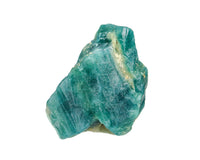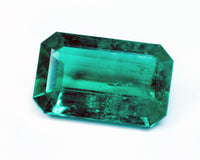- 1. Blue Topaz
- 2. History and Meaning of Blue Topaz
- 3. Metaphysical Properties of Blue Topaz
- 4. Types of Blue Topaz
- 5. Blue Topaz Healing Properties
- 6. Blue Topaz Magic Properties
- 7. Blue Topaz for Sale by KenKenGems
Blue Topaz
It is pure and transparent like a drop of morning dew. It absorbed the blue glowing of the southern night, the allure of majestic lakes, and the steel hue of the frosty sky. All of this is about gorgeous blue topaz.
History and Meaning of Blue Topaz
The origin of the term ‘topaz’ is rather vague. Some argue that it bears the name of an uninhabited island in the Red Sea, Topazios. Historical records say that the gem was discovered for the first time on this very island. Legend has it that Topazios was shrouded in a magical fog, and only the most reckless daredevils could get through to quarry jewels.
According to another theory, the name of the mineral comes from the Greek ‘topazos’, which means ‘search’. One more version refers to the Sanskrit word ‘tapas’ standing for passion, heat, and fire. Since topaz occurs in fiery colors as well, this version is plausible.
Given the property of topaz to fade in the bright light, it’s easy to believe in a mythical emergence of the stone on a foggy island. That being said, the gem’s color-changing ability mainly applies to purple and golden topaz. Blue topaz is more resistant to sunlight exposure. Even if lightens after being introduced to intense light, putting it in a dark place will help restore its original color.
Topaz has been on the radar since the dawn of civilization. Jewelry and items featuring topaz lamellar blades were found on the excavations of the sites of primitive people in the Urals. Topaz is one of the twelve stones that adorned the breastplate of Aaron, the chamber of Prester John, and the clothes of Lucifer before his expulsion from heaven. The stone is mentioned by the naturalist and philosopher Pliny the Elder in his Natural History. Ancient Indians esteemed topazes on a par with rubies and diamonds. In the Middle Ages, crusader knights brought topazes from distant lands to present as a gift for their ladies.
Metaphysical Properties of Blue Topaz
According to the chemical composition, blue topaz is an aluminum fluorosilicate with vacancies in the crystal lattice. These minute deviations in the structure of the mineral allow for the emergence of various shades of the stone. This makes it possible to treat natural blue topazes to enhance their appearance (such as color and saturation).
Some specimens of topaz show off the effect of dichroism. This means that if you look at specimens at a certain angle, they will show a different color. So, a blue topaz may appear colorless, and turquoise stones become green.
As a rule, topazes are transparent, without visible inclusions, and have a perfect cleavage. Its luster is glassy and along the cleavage it is pearly. All blue topazes are resistant to friction and impacts. In addition, they do not dissolve in acid. Topazes are fairly hard - they score 8 on the Mohs scale but if you hit them hard enough, they will shatter into many shards. The stone lends itself well to cutting and polishing.
Types of Blue Topaz
Topazes aren’t rare. This can’t be said about the blue variety. More specifically, nature tents to produce pale, barely-there blue tints that don’t really set customers in rapture. Luckily, people learned how to treat the stone with heat and radiation to improve its aesthetic properties. Currently, approximately 95% of all blue topazes have been treated one way or another.
When it comes to the most prominent varieties of the gem, these are:
- sky blue topaz;
- Swiss blue topaz;
- London blue topaz.
Natural (untreated) Sky blue topazes owe their gentle blue tint to the ions of titanium. Treated specimens are also natural – because topaz is widespread, it is cheaper to mine it than to grow in a lab. Colorless topazes undergo irradiation or heat exposure to acquire a charming light blue hue.
The color of Swiss blue topaz is vivid and bright; some specimens may showcase a touch of gray. The first high-quality Swiss blue topazes were produced in Switzerland, hence the name. Today, rough topazes to be treated to obtain this sought-after color are mined in Namibia, Australia, Japan, Brazil, Ukraine, etc. Only crystals with specific admixtures are suitable for treatment.
London Blue topazes feature the deepest blue color otherwise known as maxi-blue. This color does not occur in nature but London blue topazes are the most valuable among their peers of the same color. After treatment, some specimens take on a gray or smoky undertone. This appealing color was for the first time obtained in one of the gemological laboratories in London. At the same time, marketers note the resemblance of its color with the summer evening sky over the British capital. No matter which versions explaining this trade name you like best, London blue topazes are dangerously beautiful. Their statement color is a result of long-term neutron treatment rendering gems radioactive. To ensure they are innocuous, radiated stones are kept in a lead container for a year.
Blue Topaz Healing Properties
The healing power of blue topaz is almost limitless. It is loved around the world for its ability to fight the diseases of the nervous and musculoskeletal systems. Women appreciate its healing vibrations helping combat various disorders associated with the uterus, infertility, hormonal misbalance, as well as myopia. Topaz lends itself to curing a sore throat and respiratory issues including asthma if you wear it around the neck. Apart from that, the blue gemstones are capable of relieving stress, accelerating the body's regenerative abilities, strengthening the thyroid gland, and acting as a prophylactic for Graves' disease. The healing properties of the stone are also beneficial to those who have nightmares, depression, epileptic seizures, and insomnia.
Blue Topaz Magic Properties
This stone is of great use for people who find it difficult to express their emotions. Blue topaz jewelry helps choose the right words, become more convincing and sociable, as well as solve problems. It makes a person more confident in their actions and their consequences, as well as facilitates the realization of plans.
In the Middle Ages, blue topaz was often used to decorate royal goblets. It was believed that if poison got into such a goblet, the stone would change its color. Along with that, its color changes if it detects a liar or betrayer. The gem reveals any lie and helps see the world with clear eyes.
Blue Topaz for Sale by Kenkengems
It is luxurious, charming, and vibrant – can you deny yourself the luxury of having this gemstone? If you’re ready to discover all of its facets and features, welcome to KenKenGems, a trustworthy supplier of blue topazes and myriads of other minerals. We’ve got you covered if you’re looking for blue topaz strands, loose stones, individual large specimens, pendants, and much more. Our service, quality, and prices will make you ask for more. So don’t hesitate to browse through our extensive selection.










